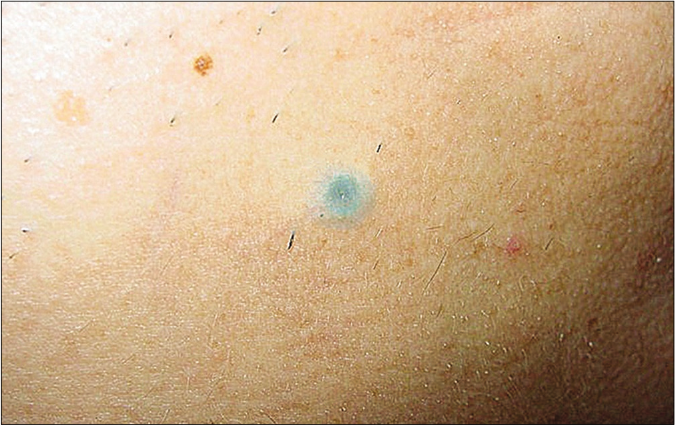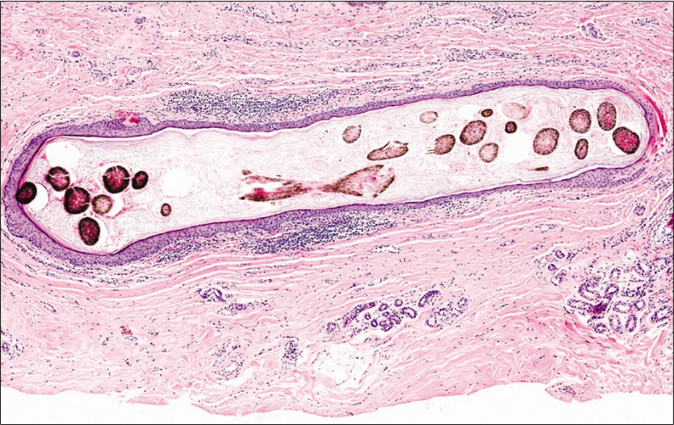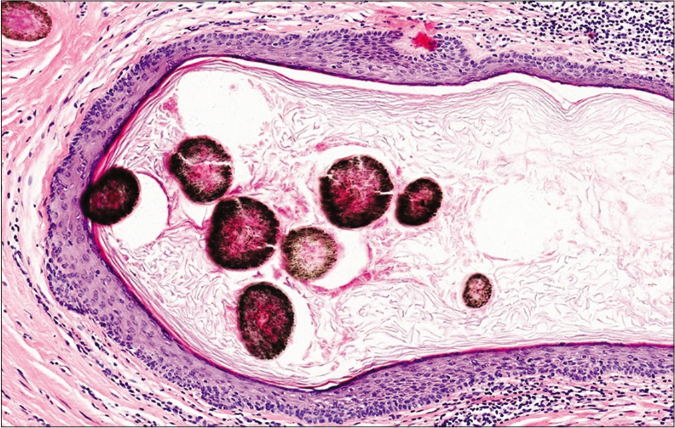Translate this page into:
A cystic nodule on the jaw
Corresponding author: Prof. Jian-Min Chang, Department of Dermatology, Beijing Hospital, National Center of Gerontology; Institute of Geriatric Medicine, Chinese Academy of Medical Sciences, No. 1, Dahua Road, Dong Dan, Beijing 100730, China. changjianmin@medmail.com.cn
-
Received: ,
Accepted: ,
How to cite this article: Lv J, Chang J. A cystic nodule on the jaw. Indian J Dermatol Venereol Leprol 2022;88:853-4.
A 59-year-old man presented with an asymptomatic nodule over the right jaw of two years’ duration. On examination, there was a slightly protuberant intracutaneous nodule, 1cm in diameter with a bluish appearance overlying the right jaw [Figure 1]. No similar lesions were noted anywhere on his body. There was no prior history of trauma, no significant past history and no family history of similar lesions. A skin biopsy was done.

- A slightly protuberant subcutaneous nodule, 1cm in diameter, with a bluish appearance over the right jaw
Question
What is the diagnosis?
Answer
Pigmented follicular cyst
Discussion
The nodule was totally resected under local anaesthesia. Histological examination revealed a cyst located in the mid-dermis, surrounded by loose fibrous connective tissue [Figure 2a]. The cyst wall comprised stratified squamous epithelium exhibiting epidermoid keratinization which consisted of stratum granulosum, stratum spinosum, and stratum basale from inside to outside. The cavity was filled with abundant keratinous material and some cross-sections of thick and deeply pigmented hair shafts which were composed of an eosinophilic medulla and numerous melanin granules [Figure 2b]. No sebaceous lobules were noted within the cyst wall.

- A cyst located in the mid-dermis with wall demonstrating epidermoid keratinization (H and E, ×100)

- Cyst cavity shows cross-sections of thick and deeply pigmented hair shafts composed of an eosinophilic medulla and melanin granules (H and E, ×200)
Pigmented follicular cyst, first described by Mehregan and Medenica about 40 years ago, is a rare variant of epithelial cysts with characteristic histology.1 The entity is most commonly described in men between 20 and 63 years of age and is mostly located on the upper body, especially the head and neck region.1
Clinically, the entity is typically characterized by a single, 0.4–1.5 cm, deep brown or bluish intracutaneous nodule or dome-shaped papule which often resembles a blue nevus, a melanocytic nevus, a histiocytoma, or a dermatofibroma.1 Multiple pigmented follicular cysts have been also described.2-4 In some rare cases, some patients with multiple lesions have a familial association.2 More infrequently, a pigmented follicular cyst can present as a pigmented ring-shaped lesion as opposed to a papule or nodule.5
Histopathologically, the entity shows a retention cyst within the mid-dermis which is lined by stratified squamous epithelium that resembles the epidermis, occasionally with some dermal papillae and rete ridges present in the cyst wall, usually in the vicinity of a hair follicle.3 Many melanin-pigmented hair shafts are observed in the cyst cavity, characterizing the microscopic appearance, and are responsible for the pigmented clinical appearance of this entity. Sometimes the cyst has a pore-like opening to the epidermis and the cyst wall presents some anagen follicles.1 On occasion, there is a degeneration of hair shafts in a pigmented follicular cyst that can be easily overlooked, leading to a misdiagnosis as an epidermal cyst.6 In some cases, a sebaceous gland can be visualized in the cyst wall, suggesting that the entity should be considered as a continuum of pilosebaceous cysts.3
The differential diagnoses of pigmented follicular cysts include vellus hair cysts, pigmented epidermal cysts and dermoid cysts. Vellus hair cysts are most often multiple 1-4 mm sized, dome-shaped skin colored to pigmented papules located on the anterior chest of young individuals (4-18 years old) without sex predilection.3,7 These cysts may be inherited in an autosomal dominant pattern.7 These can be differentiated from pigmented follicular cysts based on the content of the cysts, and vellus hair cysts contain abundant vellus hairs. Pigmented epidermal cysts are epidermal cysts with a black-brown or bluish appearance, most frequently occurring in dark-skinned races, characterized histopathologically by rich pigment granules in the cyst walls or pigmentophages in the surrounding stroma.8 Dermoid cysts typically manifest at birth, most commonly around the eyes.7 These histologically demonstrate a deep dermal or subcutaneous cyst with an epidermoid wall to which hair follicles and sebaceous glands are connected.1,7
Pigmented follicular cysts are benign cutaneous tumors, and complete excision is recommended for solitary lesions while multiple lesions can be successfully ablated by a continuous-wave CO2 laser or electrosurgery followed by curettage.4
Declaration of patient consent
The authors certify that they have obtained all appropriate patient consent.
Financial support and sponsorship
Nil.
Conflicts of interest
There are no conflicts of interest.
References
- Image Gallery: Multiple pigmented follicular cysts, with a familial association. Br J Dermatol. 2016;175:e134-5.
- [CrossRef] [PubMed] [Google Scholar]
- Multiple pigmented follicular cysts: A subtype of multiple pilosebaceous cysts. Br J Dermatol. 1996;134:758-62.
- [CrossRef] [PubMed] [Google Scholar]
- Multiple pigmented follicular cysts of the vulva successfully treated with CO2 laser: Case report and literature review. Dermatol Surg. 2004;30:1261-4.
- [CrossRef] [PubMed] [Google Scholar]
- Pigmented follicular cyst rather than solitary vellus hair cyst. Clin Exp Dermatol. 2010;35:925-6.
- [CrossRef] [PubMed] [Google Scholar]
- Pigmented follicular cyst showing degenerating pigmented hair shafts on histology. Br J Dermatol. 1999;140:364-5.
- [CrossRef] [PubMed] [Google Scholar]
- Cysts In: Bolognia JL, Schaffer JV, Cerroni L, eds. Dermatology (4th ed). Amsterdam: Elsevier-Health Sciences Division; 2017. p. :1917-29.
- [Google Scholar]





